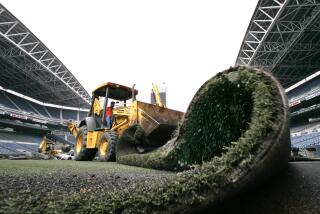SANTA CLARITA / ANTELOPE VALLEY : Lancaster in Vanguard of Drive to Recycle Tires : Environment: The city uses the waste to make a baseball field and compost bins. ‘Tire dust’ will soon be tried as an asphalt road sealant.
- Share via
LANCASTER — Three innovative tire recycling programs have made Lancaster a leader in the state’s quest to keep tires out of landfills.
Lancaster has shredded 10,000 tires into crumbs, mixed them with compost and built a baseball field. The city also is using thousands of recycled tires to make compost bins. Soon it will start using “tire dust” as an asphalt road sealant.
The programs are the result of $196,000 in grants that Lancaster received last year from the California Integrated Waste Management Board.
“In California, tires are not a real significant percentage of the trash, but they are a real problem,” said Jesse R. Huff, chairman of the state board, citing a state law that took effect more than a year ago that prohibits whole tires from being buried in landfills. Cut tires are still permitted.
Huff said 28 million waste tires are generated in California each year. “We’ve found something to do with 11 million of them, (but) 17 million every year we don’t have a use for.”
Huff said it is hoped that programs such as those in Lancaster will lead to a viable way to keep tires out of landfills.
Like the ball field made of tire crumbs, officials said the compost bins made of steel-belted radial tires are the first to be produced in California.
A Lancaster-based firm, K&E; Engineering, developed the necessary equipment, including a die to punch out dog-bone-shaped tire scraps, and members of a local nonprofit organization have begun assembling compost bins.
Each bin--3 feet tall, 3 feet in diameter and held together with plastic tubing--is built from 364 of the dog-boned tire scraps and 700 small discs cut from four tires.
In all, the 95-pound bins contain nearly 93% recycled materials. The grant from the state provides enough funds for the assembly of 1,800 bins, each of which can hold a cubic yard of compost.
Ray Olson, Lancaster’s recycling coordinator, said once the bins are distributed to community groups and sold to residents they will do more than just keep waste tires out of the local landfill. Bin users will also be recycling green waste, such as yard clippings.
K&E; Engineering is also searching for uses for the 30% of each tire that is not usable in the making of the compost bins. Company President Ed Read said possible uses for the scraps include erosion control material and tree supports.
At the tire-crumb softball field, officials said they are getting good results. Grass on the field is growing better than on an adjacent field that was not amended with tire crumbs, said Kent Kurtz, a Cal Poly Pomona horticulture/plant and soil science professor who has been monitoring the fields since they were tilled three months ago.
Water is being absorbed into the tire crumb field better than on the other field, he said.
“Early on, I wasn’t sure what the results would be,” said Kurtz. “I’m very encouraged by what I see.”
Fewer sports injuries are anticipated on the tire crumb field, although Kurtz said it is too early to tell if the field’s resiliency will prove to be as high as expected.
Test patches of the asphalt sealant made from tires may be applied in the next 60 days.
More to Read
Sign up for Essential California
The most important California stories and recommendations in your inbox every morning.
You may occasionally receive promotional content from the Los Angeles Times.













